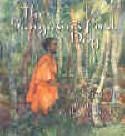Contribute
| Book Review - The Sanyasin’s First Day |
Tara Menon
08/08/2005
The Sanyasin’s First Day
by Ned Shank
Marshall Cavendish, 1999
Ned Shank’s The Sanyasin’s First Day, about first time occasions, was fittingly enough the author’s first picture book for children. Unfortunately it was his last book as he died in an accident a year after its publication in 1999. The inspiration to write the story struck him during a visit to India when he saw a rotund sanyasin in a bakery and the person he was with remarked that it was probably the sanyasin’s first day. The author could also have been motivated to help children realize that first day jitters are common and not exclusive to them.
The clue to the setting of The Sanyasin’s First Day is given in the illustrations, which depict board signs in Malayalam. The book links the first day of a sanyasin, a plumber, a policeman, a farmer, and a schoolboy. The reader understands that seemingly trivial interaction between strangers or acquaintances can have positive affects. The strength of the story, however, lies more in the tender detailed depiction of Indian culture. The author has created a cast of characters we never know intimately, but who are portrayed lovingly.
After Shank gives the reader a straightforward explanation of who a sanyasin is, he plunges the reader into Indian life. The sanyasin’s goal for the day, to have his rice bowl filled, only requires him to sit under the shade of a tree. Life swirls around him, but no one stops to put any rice in his bowl. Whether the sanyasin’s wish will come true hinges on the cycle of events that will take place involving the characters who will have their own first ordeals.
We meet a woman plumber standing on the doorstep of Mrs. Krishnan’s house. Her wish is less simple than having a bowl of rice filled, but fortunately she doesn’t have to depend on anyone else for its fulfillment. She just wants to do a good job of installing a new kitchen sink. Shank quickly shifts his lens to the traffic policeman who too wants to do his duty well. The author’s description of him is detailed. “He was dressed in his official uniform, with a black-brimmed cap pulled down over his eyes, crisply-ironed khaki shortsleeved shirt with braid looping over the right shoulder, uniform shorts with military buckled belt, long brown woolen socks and official shiny heavy brown boots. His hands were in white gloves, and a silvery metal whistle on a white cord hung in his mouth.†Shank now introduces the female farmer who is driving an oxen cart, carrying rice to sell at the granary in the town. She confides to the oxen that she hopes she will get a good price for her load.
The simplicity of the characters is appealing and helps make us feel the oneness of the world that the author is trying to show. The sanyasin leaves it up to God to answer his prayer. The housewife cooks lunch for herself, her son, and the plumber. The farmer’s unique way of doing business by letting the buyer name the price stands out in the market place. The policeman takes the time to give directions to the farmer though traffic is chaotic with “honking taxis and beeping three-wheeled open autorickshaws and rumbling paint-decorated lorries and bicycles with their bells clanging and the oxcarts from the country all around him..â€
Catherine Stock is a first rate illustrator who has created eighty picture books for children. The watercolor scenes in the book are the result of talent and good research. They are in line with the traditional Indian illustrations for children, but Stock has at the same time given them a modern look. The pictures immerse the reader in the hustle and bustle of a Kerala town and also convey the charms of nature the state is famous for. She, like the author, adds to the likeability of the characters by her depictions, especially the schoolboy.
But since the picture book doesn’t develop the characters’ apprehensions, there is a limit to the depth of the message and since it doesn’t show anyone ultimately botching his or her task it doesn’t address the issue of failure. However Shank has approached the subject of first time occasions in an original way and shown that whether we are male or female, city dwellers or villagers, our hearts beat with the same hope.
You may also access this article through our web-site http://www.lokvani.com/
